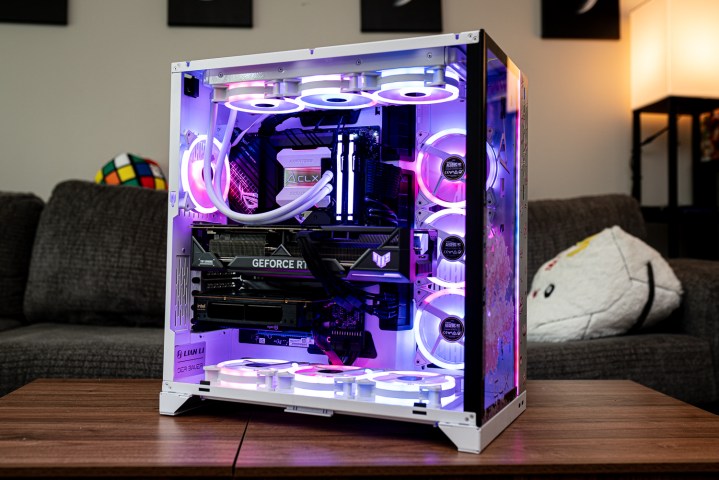
The CLX Hathor is absurd. That’s not inherently a bad thing — a lot of the best gaming PCs are absurd in one form or another — but the idea of packing two PCs into one case with the most powerful hardware available today (while charging a clean $7,000 for it) is ridiculous.
But CLX did it. It’s not a new concept. Dual-PC setups have been a staple of streaming for years, and machines like the Origin Big O cram a gaming PC, streaming PC, PlayStation 5, Xbox Series X, and Nintendo Switch into a single case (you can’t buy it, for what it’s worth). By that standard, the CLX Hathor is quaint, and that’s maybe why it’s so interesting. It doesn’t break new ground, but it makes the dual-PC setup more convenient than ever. The question still remains, though: Why would anyone buy this?
Why would anyone buy this?
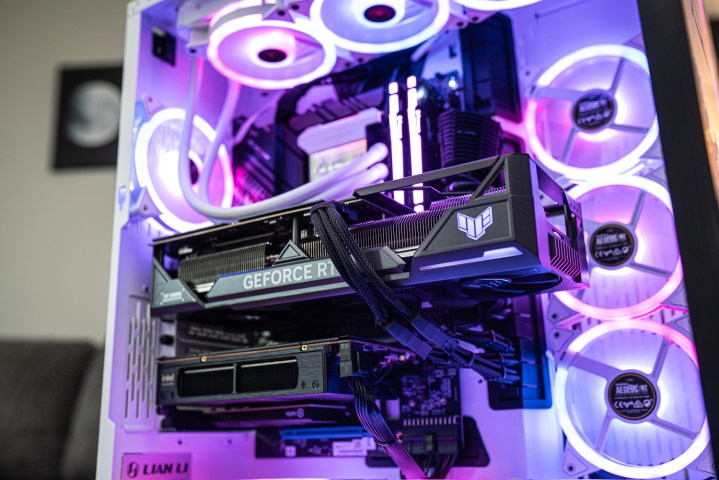
The obvious and easy answer is streaming, which is what you’ve probably seen shouted from the rooftops for the better part of a decade. The idea is that you put the streaming workload on one PC so that your main PC is freed up to just run the game. It’s an answer that held a lot of weight several years ago. Today? Not so much.
We’re in an era of very fast GPU-based encoders. Years ago, with CPU-based encoding and limited available threads, you would sometimes take a performance hit of 30% or more by turning on stream. In most cases, your stream would also be choppy, with your components modulating between prioritizing the stream and prioritizing your game. This resource scarcity is not something modern PCs need to really think about.
Today, CPUs have more threads than they know what to do with, and GPU-based encoders from AMD and Nvidia offer single-digit hits to performance with consistent quality. I ran a few tests on just the gaming portion of the Hathor, utilizing the RTX 4080 in the machine for encoding while also running a game. In Assassin’s Creed Valhalla, I dropped from 180 frames per second (fps) to 176 fps when I started streaming. In Cyberpunk 2077 with ray tracing cranked, I went from 87 fps to 85 fps.
These tests were run at 1080p with a 1080p stream, and there’s definitely more strain on your components when pushing the highest-quality video and high resolutions. Even when pushing 4K in Assassin’s Creed Valhalla while also capturing at 4K, though, I only dropped a few frames.
For straightforward streaming/recording, the reality is that a single, high-performance PC makes more sense than a dual PC setup for most people. There are, however, a few cases where two PCs have an edge.
Inside the Hathor
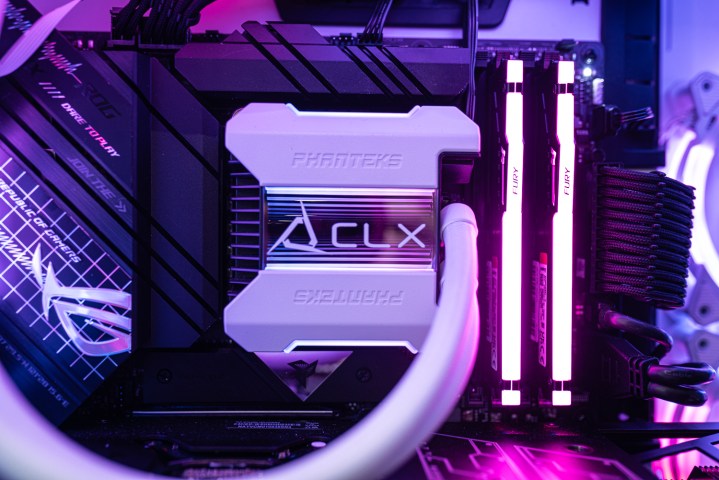
Let’s talk about what the Hathor actually is, though. It’s two PCs stuffed into one case. These PCs don’t communicate with each other at all. They are two separate PCs in the same case, fit with separate power supplies, video outputs, and USB ports.
CLX just brings them together in one case — in particular, the Lian Li PC-O11 Dynamic XL. The main PC is your standard affair. My review unit came packed with an RTX 4080 and Core i9-13900K, but CLX gives you options to trick out the Hathor however you like with GPUs from AMD, Nvidia, and Intel, and close to a dozen CPU options from Intel.
| CPU | Intel Core i9-13900K / Intel Core i9-12900 |
| GPU | Nvidia RTX 4080 / Intel UHD 770 |
| Motherboard | Asus ROG Strix Z690-G Gaming WiFi Micro ATX / NUC motherboard |
| Case | Lian Li PCO11D XL |
| Memory | 2x 16GB Kingston Fury Beast DDR5-5200 / 2x 8GB DDR4-3200 |
| Storage | 1TB Samsung 980 Pro, 4TB Seagate Barracuda / 1TB Samsung 980 Pro |
| Power supply | 1000W EVGA G5 80 Plus Gold / 750W Phanteks AMP 80 Plus Gold |
| Capture card | Elgato 4K60 PCIe |
| Price | $7,114 |
Customization goes so much further, too. I counted nearly 30 different kits of RAM on tap, 27 different power supplies, over 50 different hard drive configurations, and 15 different CPU coolers. There are a ton of options here.
Most of that customization applies to the second PC. It sits below the main PC on a tiny, proprietary motherboard. CLX uses Intel’s 12th-gen NUC Compute Element for the second PC. You have two CPU options, three memory kits, and the same amount of SSD customization as you do with the main PC. This second PC also comes with a capture card installed: the Elgato 4K60 Pro.
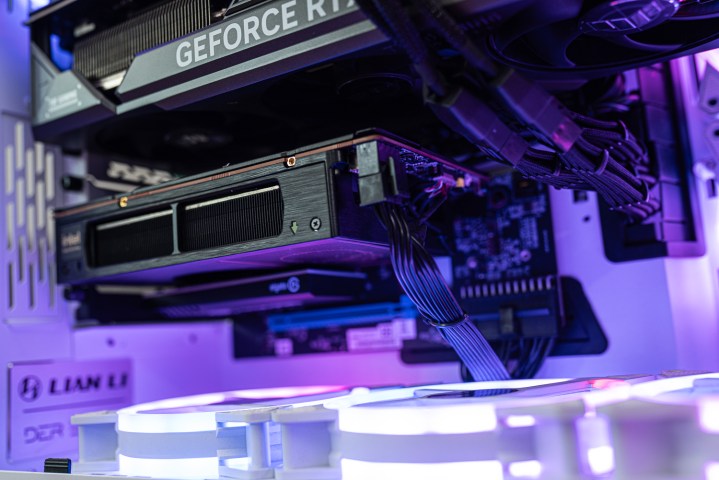
Both PCs live under the same roof, but they’re neighbors, not relatives. Setting up your stream is identical to if you had two separate PCs. Your main PC runs through the capture card of your second PC, and your second PC runs the stream while the main PC runs the game. The two don’t share anything, so you’ll need separate monitors and peripherals (short of tricks like Mouse Without Borders, a KVM switch, or picture-in-picture on your monitor).
And that’s where dual PC setups start to lose me. Sure, maybe you can swap your keyboard and mouse over after jumping through a few hoops, but what about everything else? You need to swap your microphone over for Discord calls, maintain audio for two separate PCs, and maintain two internet connections to stream and play any games online. It’s possible, absolutely, but everything is doubled. And, as we’ve established, a single PC is more than capable of delivering solid performance while streaming or recording.
Where the Hathor shines

Let’s not write off the Hathor entirely, though. There are situations where a dual PC setup makes a lot of sense, particularly for reliability. Separating your game from your stream means your stream can keep running even if your main PC goes down. There’s also something to be said about highly complex streams with multiple cameras and scenes running through a separate PC so as to not overload the amount of micromanaging you need to do while playing a game. That’s not to mention the footprint of the Hathor. It’s a monstrous PC that arrives in its own wooden crate, but it’s still far more manageable than two entirely separate PCs.
It’s also a very powerful PC. Ignoring the price — which I’ll get to shortly — CLX is squeezing the most amount of power possible out of this machine. It has all of the proper BIOS settings, from XMP to ReBAR, allowing you to get the most out of the machine. I gathered my numbers after a single driver update, and you rarely find desktops that perform this well almost out of the box.
| Cinebench R23 Single/Multi | 2,130 / 36,446 |
| Geekbench 5 Single/Multi | 2,113 / 23,594 |
| 3DMark Time Spy | 26,402 |
| 3DMark Fire Strike | 43,909 |
| Assassin’s Creed Valhalla | 95 fps |
| Forza Horizon 5 | 134 fps |
| Gears Tactics | 118 fps |
| Cyberpunk 2077 | 64 fps |
| Cyberpunk 2077 Ray Tracing | 29 fps |
| Cyberpunk 2077 Ray Tracing w/ DLSS 3 | 115 fps |
In addition, the Hathor is expertly put together. Looking at the front and the back, it looks like CLX made the cables disappear, utilizing cable combs to straighten out runs, cable management plates to hide the mess, and proper routing to the front of the case. CLX even managed to make Nvidia’s silly 16-pin adaptor look good, which is a feat in itself.
Not for most people

Even with those upsides, there are only a select few people who actually need something like this. “Need” is important here, too. If you don’t need two PCs for streaming, you’re just creating more headaches getting everything set up.
That’s before we bring price into the mix, too. At the time of writing, the Hathor I looked at would cost you $7,114. For context, you could build two of CLX’s Horus midtower PCs, both packing a Core i9-13900K and RTX 4080, for $6,534. Not only is that $600 cheaper than a single Hathor, but you’re also getting two of the most powerful PCs money can buy. They take up more space, absolutely, but it’s hard to justify the premium of the Hathor when more hardware, and much better hardware, costs less when spread across two PCs. If you went with something equivalent — say a Horus and a prebuilt NUC with a high-end external capture card — you’re saving closer to $3,000.
That’s the reality of the Hathor. It’s an expensive PC that does the same thing that you can do with two PCs for far less money. I want to steer you away from the Hathor, but not CLX as a company. The Hathor is a master class in build quality, somehow managing two PCs worth of hardware in a single case, and with better cable management than you see in a lot of individual PCs.
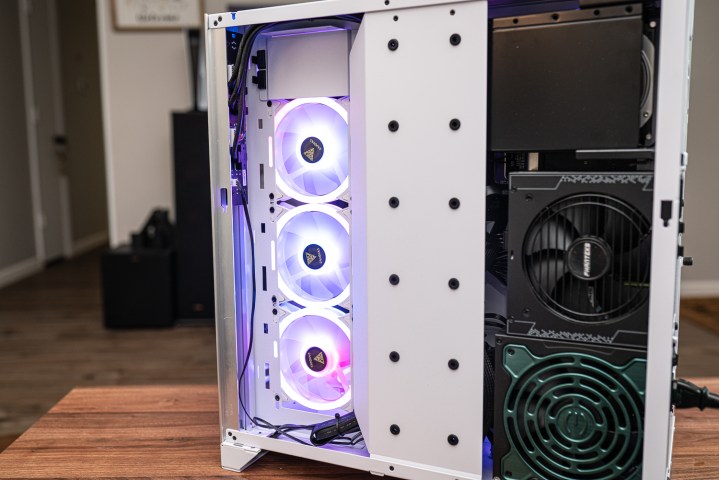
You can read our CLX Scarab review to see more about what the company can pull off in a single PC rig, which is pretty impressive. For the Hathor, it came free of bloatware and with several helpful stickers to guide newcomers along. The company also included all of the extra modular cables and some useful accessories like a USB-C to DisplayPort adaptor from Cable Matters. From top to bottom, it’s clear CLX cares about selling a good product.
If the Hathor sounds like an answer to your problems, and you don’t mind willingly spending up for what it offers, you’ll be very satisfied. For everyone else — and I imagine that group includes most people — you should shop CLX’s other machines instead of putting all your chips on the Hathor.




